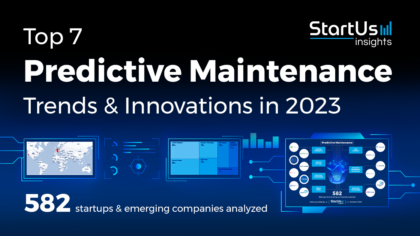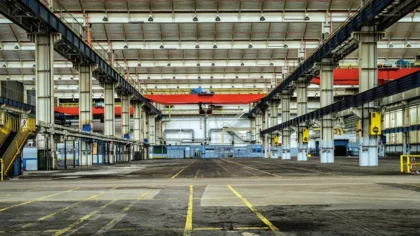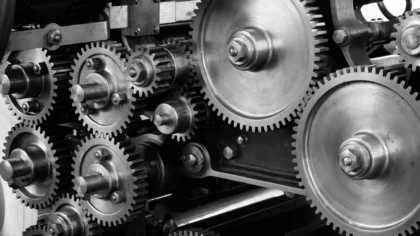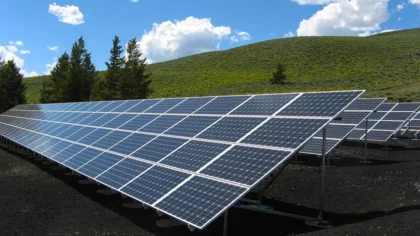Asset integrity and safety compliance are integral for all industries to maximize profits. Therefore, businesses are transitioning to a proactive maintenance approach to predict failures and track equipment performance in real-time. Predictive maintenance (PdM) enables them to detect abnormalities and possible defects before it results in breakdowns. This article provides an overview of the top 7 predictive maintenance trends & innovations ranging from artificial intelligence (AI), the Internet of Things (IoT), and digital twins to advanced inspection and immersive technologies. Read more to explore how they impact your business.
Innovation Map outlines the Top 7 Predictive Maintenance Trends & 14 Promising Startups
For this in-depth research on the Top Predictive Maintenance Trends & Startups, we analyzed a sample of 582 global startups and scaleups. The result of this research is data-driven innovation intelligence that improves strategic decision-making by giving you an overview of emerging technologies & startups in Industry 4.0. These insights are derived by working with our Big Data & Artificial Intelligence-powered StartUs Insights Discovery Platform, covering 2 500 000+ startups & scaleups globally. As the world’s largest resource for data on emerging companies, the SaaS platform enables you to identify relevant startups, emerging technologies & future industry trends quickly & exhaustively.
In the Innovation Map below, you get an overview of the Top 7 Predictive Maintenance Trends & Innovations that impact companies worldwide. Moreover, the Predictive Maintenance Innovation Map reveals 14 hand-picked startups, all working on emerging technologies that advance their field.
Top 7 Predictive Maintenance Trends & Innovation
- Artificial Intelligence
- Internet of Things
- Inspection Technologies
- Digital Twins
- Predictive Analytics
- Predictive Maintenance as a Service
- Immersive Technologies
Tree Map reveals the Impact of the Top Predictive Maintenance Trends
Based on the Predictive Maintenance Innovation Map, the Tree Map below illustrates the impact of the Top 7 Predictive Maintenance Trends in 2023. Startups and scaleups are developing AI and data analytics solutions to derive patterns of manufacturing plant behaviors and anticipate defects. They are also leveraging IoT to bring remote and centralized monitoring of machinery. Further, inspection technologies deliver enhanced accuracy to the equipment health check while digital twins and immersive technologies enable virtual interaction with the tools and technician teams. By providing predictive maintenance as a service (PdMaaS), engineering teams accelerate PdM deployment. This way, tech-driven innovations empower manufacturers with a fast, precise, and cost-effective way to forecast potential asset degradation.
Global Startup Heat Map covers 582 Predictive Maintenance Startups & Scaleups
The Global Startup Heat Map below highlights the global distribution of the 582 exemplary startups & scaleups that we analyzed for this research. Created through the StartUs Insights Discovery Platform, the Heat Map reveals the highest startup activity in Western Europe, followed by the US and India.
Below, you get to meet 14 out of these 582 promising startups & scaleups as well as the solutions they develop. These 14 startups are hand-picked based on criteria such as founding year, location, funding raised, and more. Depending on your specific needs, your top picks might look entirely different.
Top 7 Predictive Maintenance Innovation Trends for 2023
1. Artificial Intelligence
Industries leverage AI, machine learning, and deep learning to analyze massive real-time data and predict asset breakdowns by detecting systematic failure patterns. To examine equipment conditions, they collect data from in-machine sensors and past service records. Such solutions then inform operators about particular components that require potential maintenance or replacement. This way, AI-driven predictive maintenance reduces the costs associated with unscheduled maintenance while ensuring worker safety.
ai-omatic solutions offers AI-driven Predictive Maintenance
ai-omatic solutions is a German startup that develops cloud-based software for predictive maintenance. It utilizes AI and statistical models to evaluate and visualize sensor data from machines. The software detects anomalies, predicts failures, and identifies root causes. ai-omatic solutions provides an overview of the component health status in real-time and sends up-to-date alerts of potentially detrimental machine behaviors. This reduces maintenance costs and optimizes resource utilization.
alteco.ai aids Energy Optimization
Israeli startup alteco.ai provides an AI-based energy optimization platform. It analyzes harmonic voltages and currents to identify and disaggregate devices. This non-intrusive method enables manufacturers to take measurements as well as detect anomalies in energy consumption and forecast future machinery faults. The platform also features advanced reporting, multi-site management, and smart alert webhooks. As a result, alteco.ai decreases manufacturing costs increases efficiency and avoids unplanned downtime.
2. Internet of Things
IoT-driven predictive maintenance enables manufacturers to connect and monitor existing assets in a centralized manner. Smart sensors allow maintenance teams to gather real-time information such as operating temperature, supply voltage, current, and vibration. This information is crucial to forecast machine failures and mitigate downtimes. Thus, IoT in predictive maintenance leads to efficient use of machines, improved safety, and optimized production processes.
sAInce.io offers an Industrial IoT Platform
Belgian startup sAInce.io creates IIoT Verse, an industrial IoT (IIoT) platform. It features edge controllers to monitor interconnected devices in real time. The platform automatically translates the sensor address and connects with its serial numbers, eliminating downtime during calibrations. It also provides cloud storage, object detection, anomaly detection, and other solutions useful for PdM. The platform thus offers interactive data transfer among devices and enables technicians to take action proactively.
PANTOhealth builds a Sensor-based PdM Platform
PANTOhealth is a German startup that builds a sensor-based train predictive maintenance platform. It consists of hardware and software components, Data Hunter and Data Farmer, which collect data from sensors to simulate running trains. The sensors collect data such as acceleration, temperature, location, and speed of the train components. This combination of real data and synthetic data enables predictive maintenance. Further, this data powers analytics useful in determining the best time for repairing to save time and costs.
3. Inspection Technologies
Systematic condition monitoring is an essential part of predictive maintenance and facilitates the prevention of machine failures. Inspection technologies evaluate equipment degradation levels based on microcracks, corrosions, vibrations, temperature, etc. Such solutions include infrared thermography, ultrasonic analysis, vibration monitoring, and robotic inspection, among others. The non-invasive nature of these techniques enables precise and cost-effective machine testing. Moreover, the combination of multiple methods accurately indicates the probable source of deterioration, improving asset reliability.
Touch Sensity enables Sensor-Free PdM
Touch Sensity is a French startup that creates Sensity Tech, a sensor-free scanning technology by leveraging intelligent materials. The startup makes materials sensitive to physical mechanical interactions. This enables non-invasive monitoring based on the real-time structural information from the material surface and records the data. Further, mathematical models use this data to detect, localize, characterize and model damaged areas. This way, manufacturers are able to scan the internal state of various surfaces without sensors, enabling predictive maintenance.
DTEC offers Ultrasonic Testing
DTEC is a German startup that provides ultrasonic testing for equipment condition monitoring. The startup’s non-destructive testing (NDT) technique combines ultrasonic wave propagation and machine vision. This provides imaging and diagnostics of wheel cracks with higher resolution and quality. Since frequent inspection and documentation are crucial for an effective maintenance program, the startup provides a cost-effective method to detect developing faults.
4. Digital Twins
Current technologies are inadequate to track the dynamic changing conditions of manufacturing operations and equipment. Digital twins generate a virtual replica of physical equipment. This enables manufacturers to continuously monitor actual working conditions and accurately visualize future scenarios. This enables the prediction of anomalies and problematic areas causing breakdowns. Digital twins in predictive maintenance also simulate different situations to understand risk factors affecting machine performance. This results in better-informed decision-making to mitigate critical problems with actionable plans.
SensHero aids Asset Malfunction Prediction
SensHero is a Turkish startup that predicts potential malfunctions using digital twins and data analysis. Through its sensors, the startup’s solution collects telemetry data from machines. Based on this data, it creates a real-time digital twin by a applying kinematic scheme. The digital twin technology minimizes unplanned breakdowns by modeling equipment under various types of conditions with more accurate data.
Cerexio simplifies Asset Visualization
Cerexio is a Singaporean startup that simplifies asset visualization through a digital twin system. The startup’s technology offers virtual models of critical physical components to improve visibility into machinery and factories. This allows asset managers to establish event-driven predictive maintenance strategies based on structural indexes and equipment performance metrics. Additionally, the startup integrates LiDAR and GIS to achieve extended data representations, optimizing resources, time, and money in mitigating risks.
5. Predictive Analytics
Predictive analytics-driven PdM solutions analyze unstructured data, such as sensor readings, past reports, and environmental parameters, to predict failures. As a result, startups and scaleups are developing analytical tools that synthesize data and cluster information. Further, big data platforms improve the transparency of system health conditions. This also enables precise modeling and effective forecasting by examining patterns in large datasets. These data-driven predictions provide valuable insights for better-informed business decisions and reduced turnaround time.
Preventio builds a Data-Driven Maintenance Platform
Preventio is a German startup that makes a data-driven predictive maintenance platform. Its cross-industry data pool leverages existing building data and external data sources. Using this data, the platform makes information maps that provide insights into potential high-risk pipe leaks, predicting pipe deterioration and failures. Moreover, this method offers a better foundation to estimate future investments and repairs while mitigating expensive sensors.
AWAKE Mobility delivers Predictive Data Analytics
AWAKE Mobility is a German startup that delivers predictive data analytics for public transport. By analyzing vehicle data, the startup’s solution monitors fleet health status and predicts future technical problems. It eliminates information asymmetry between departments, thereby providing actionable insights to improve internal processes. Through predictive analytics, the solution also detects the exact time to fix faults and root causes of problems. This way, AWAKE Mobility increases vehicle availability, reliability, sustainability, and overall performance.
6. Predictive Maintenance as a Service
Predictive maintenance as a service makes PdM accessible and affordable for manufacturing plants. To aid this, startups are offering cloud-based PdMaaS solutions. They mitigate infrastructure costs and allow manufacturers to leverage existing components, further reducing costs. Such solutions also enable on-demand access to predictive maintenance and improve scalability. Moreover, PdMaaS removes infrastructure and development costs.
Symphony offers On-Demand PdM
Symphony is a Chinese startup that provides a predictive maintenance platform on demand. It wirelessly monitors vibrations in machinery equipment and sends data to the cloud. Then, the platform analyzes the data to diagnose the health status of the machines and their remaining useful time. By providing a subscription model the startup eliminates high upfront costs and facilitates the testing of sensors without plant risks. As a result, Symphony’s cross-vertical solution enables flexible, risk-free, and cost-effective downtime prevention.
Sonnefy provides Solar Plant PdMaaS Software
Sonnefy is an Estonian startup that offers PdMaaS for solar plants. The startup combines digital models, drone-based infrared inspections, and machine learning to assess the efficiency of solar power plants. This results in detailed downtime reporting and financial performance analytics. This way, Sonnefy provides real-time monitoring while lowering maintenance costs and improving productivity.
7. Immersive Technologies
Startups are using extended reality (XR) to simplify asset inspections. Augmented reality (AR) and virtual reality (VR) platforms simplify on-site inspection, failure documentation, and paperwork follow-up. Through headsets and smart glasses, technicians are able to visualize historical component data, thereby accelerating in-situ diagnostics. At the same time, AR collects data from equipment sensors to navigate predictive maintenance plans. As a result, immersive technologies enhance on-the-spot visualization and enable early fault detection.
SpaceIntel advances VR-enabled Facility Maintenance
SpaceIntel is a US-based startup that provides VR-based facility maintenance and repair. The startup leverages VR, 3D interactivity, and predictive analytics to increase operational efficiencies. This creates a platform for remote asset monitoring and management. The VR-based platform also facilitates the integration of predictive maintenance by simplifying the equipment check procedure and communication between technicians. Further, virtualization provides increased data capture and decreases the time for on-site inspections.
Simovate offers AR-powered Predictive Maintenance
Turkish startup Simovate develops AR-based predictive maintenance. The startup uses predictive analytics and augmented reality to provide users with the causes of malfunctions. It also demonstrates the instant information from sensors on machinery. The advanced visualization makes PdM intuitive and easy to comprehend for technicians, significantly improving operational excellence and execution times.
Discover all Predictive Maintenance Trends, Technologies & Startups
Predictive maintenance is extensively integrating AI, IoT, data analytics, digital twins, and immersive tech. They enable manufacturers to forecast and prevent potential damages in precise, efficient, and cost-effective ways. Further, the combination of multiple inspection technologies and new software models like PdMaaS expands existing tools to detect abnormalities without financial and operational risks. Futuristic technologies will enable machines to perform self-maintenance, thus fully eliminating the need for human intervention.
The Predictive Maintenance Trends & Startups outlined in this report only scratch the surface of trends that we identified during our data-driven innovation and startup scouting process. Among others, AI, an array of smart sensors, and simulation software will transform the sector as we know it today. Identifying new opportunities and emerging technologies to implement into your business goes a long way in gaining a competitive advantage. Get in touch to easily and exhaustively scout startups, technologies & trends that matter to you!











